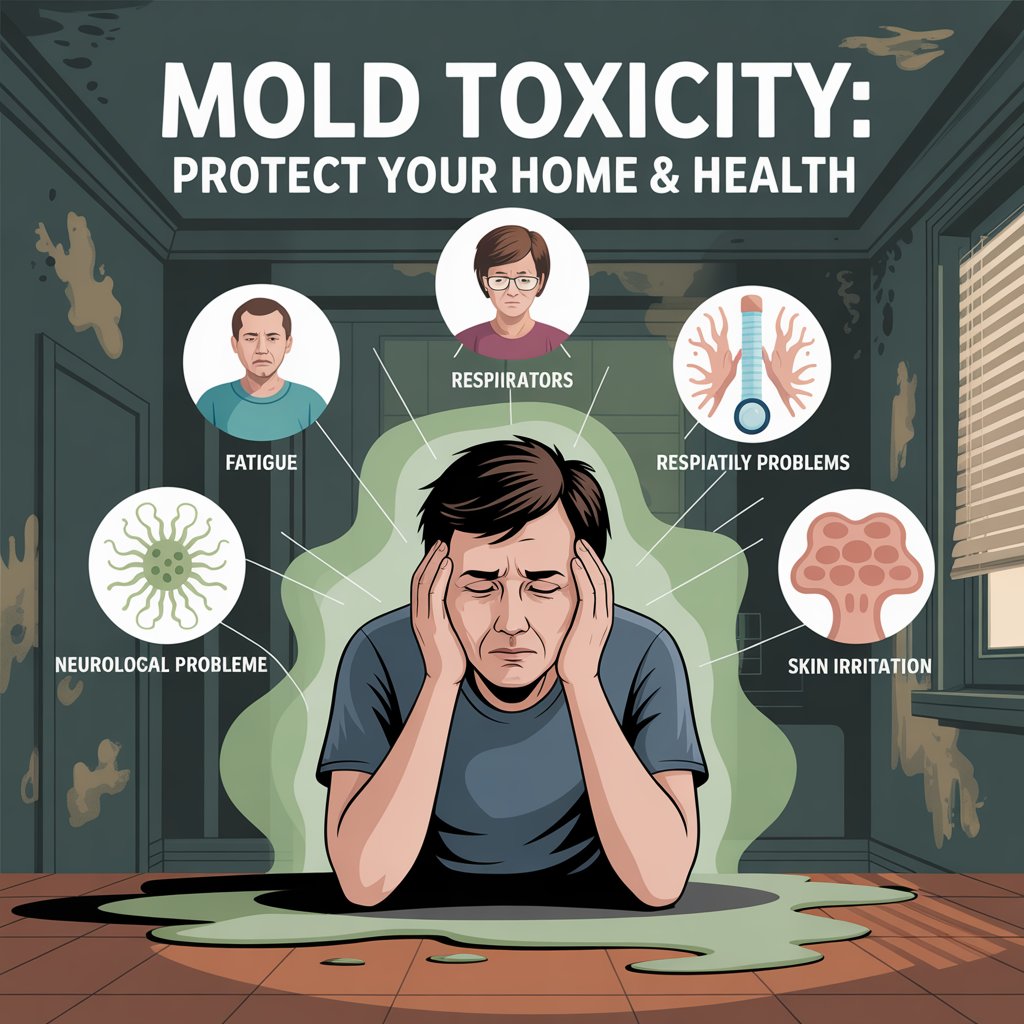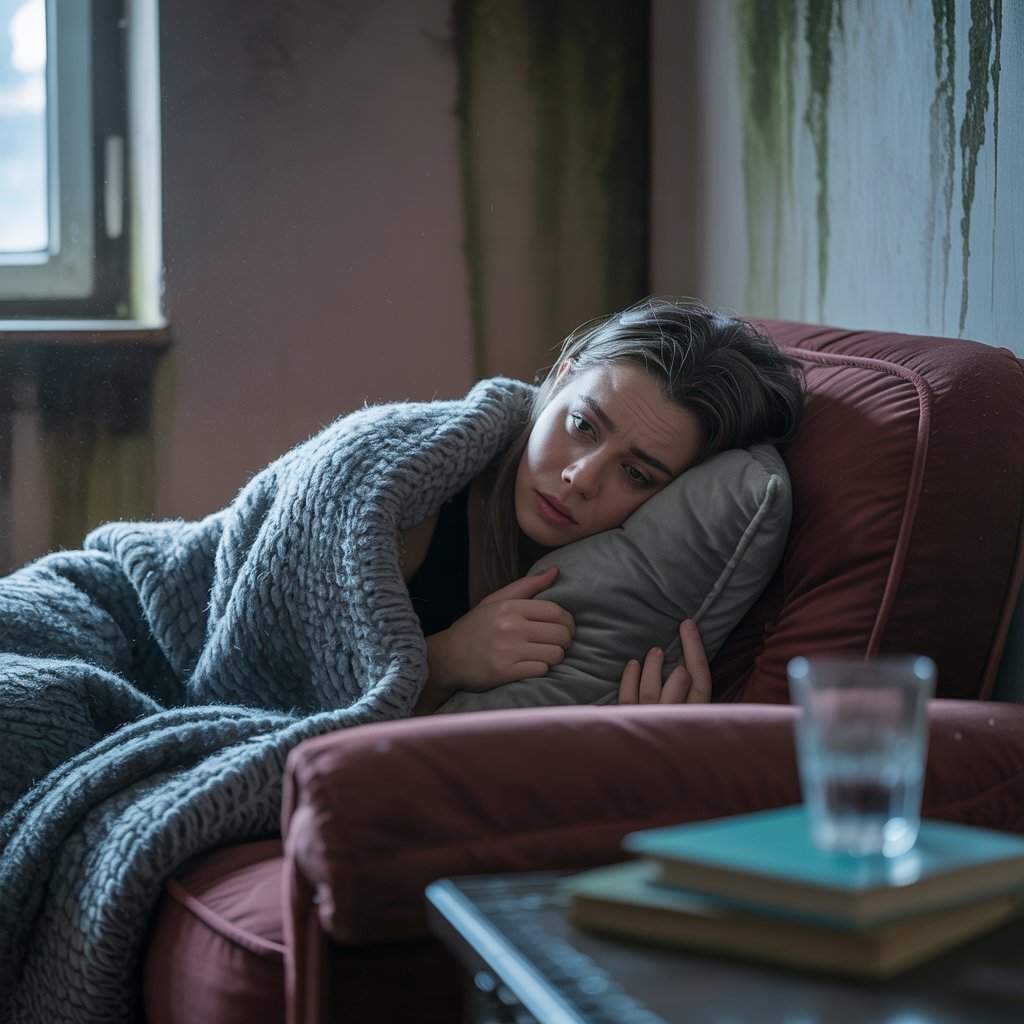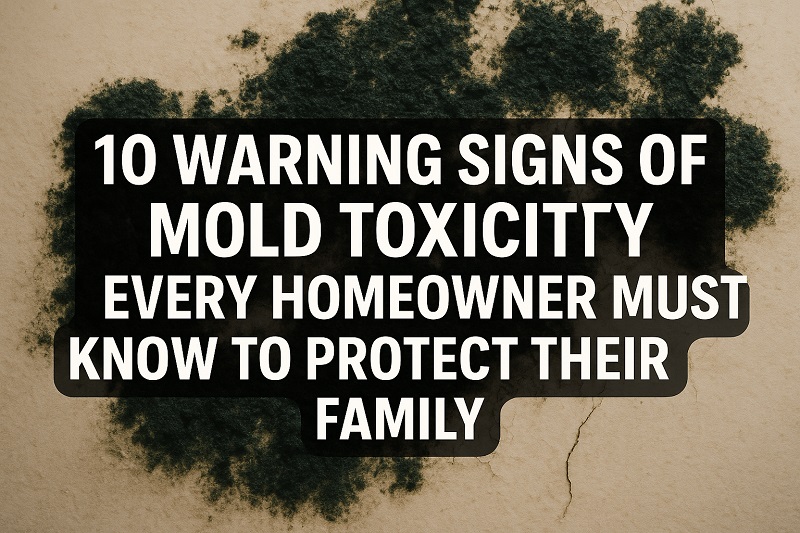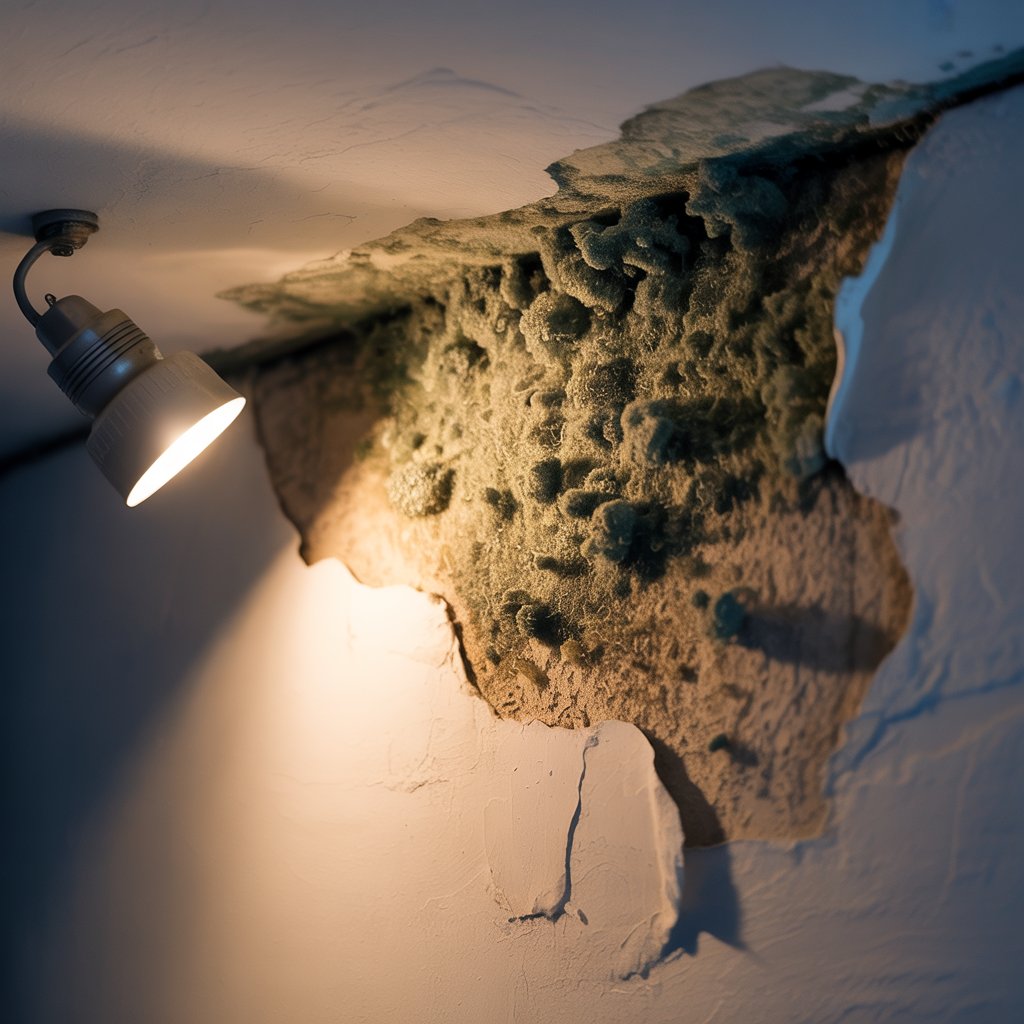Could your home be making you sick? For USA homeowners, the 10 warning signs of mold toxicity are critical to recognize, as mold lurks in places you might not suspect. The CDC estimates that 50% of U.S. homes have mold issues, and the toxic compounds (mycotoxins) produced by molds like Stachybotrys chartarum (black mold) can harm your health. From unexplained fatigue to persistent coughs, these 10 warning signs of mold toxicity could be your clue to a hidden problem. This article breaks down each sign with clear, relatable descriptions, backed by science, to help you protect your family.

What Are the 10 Warning Signs of Mold Toxicity?
Mold toxicity symptoms can be subtle or severe. Here are the most common signs to look out for:
- Chronic fatigue
- Respiratory problems
- Frequent headaches
- Skin irritations
- Brain fog
- Allergic reactions
- Muscle and joint pain
- Digestive problems
- Mood swings
- Unexplained weight changes
What Is Mold Toxicity?
Mold toxicity, also known as mycotoxicosis, occurs when exposure to mycotoxins—toxic chemical compounds produced by certain molds—triggers adverse health effects. Unlike common mold allergies, which affect only sensitive individuals, the 10 warning signs of mold toxicity can impact anyone, making it a critical concern for USA homeowners. Molds like Aspergillus, Penicillium, Fusarium, and Stachybotrys chartarum (commonly called black mold) produce these potent toxins. According to the EPA, mycotoxins can disrupt multiple bodily systems, including respiratory, neurological, and immune functions, leading to symptoms ranging from chronic fatigue to cognitive impairment.

Why Mold Is Dangerous
Mycotoxins are secondary metabolites that molds use for defense, but they cause serious harm to humans. For example:
- Aflatoxins (from Aspergillus) can damage DNA.
- Trichothecenes (from Stachybotrys) impair protein synthesis and cause neuroinflammation.
A 2022 Neurotoxicology study confirmed that these toxins may cross the blood-brain barrier, leading to brain fog, mood swings, and memory issues.
Why It Matters to Homeowners
For USA homeowners, mold toxicity is a hidden threat. The CDC estimates that 50% of U.S. homes have conditions conducive to mold growth, increasing the risk of mycotoxin exposure. Unlike visible mold, mycotoxins are microscopic and can linger in dust or air, even after mold is removed. For example, a Colorado family experienced persistent respiratory issues despite cleaning visible mold, only to discover mycotoxins in their home’s air vents through professional testing. Recognizing the 10 warning signs of mold toxicity is crucial because prolonged exposure can lead to chronic health issues, including asthma (linked to mold in 7% of global cases, per WHO) or immune suppression.
Who’s at Risk?
Everyone in a mold-affected home is vulnerable, but children, the elderly, and those with pre-existing conditions face higher risks. A 2020 Journal of Environmental Health study found that children exposed to mycotoxins are 30% more likely to develop respiratory issues. Homeowners should stay vigilant for the 10 warning signs of mold toxicity, as early detection can prevent long-term health damage and costly remediation.
How Mold Grows in Homes
Mold thrives in environments that are damp, warm, and poorly ventilated, making USA homes—especially those in humid or flood-prone regions—prime targets. The EPA notes that mold requires three things to grow: moisture (humidity above 60%), a food source (like drywall or wood), and stagnant air. From leaky pipes to post-storm flooding, homes face numerous risks that can trigger mold growth, leading to the 10 warning signs of mold toxicity if left unchecked.
Conditions That Fuel Mold
Mold spores are naturally present in the air, but they only grow when conditions are right. High humidity (above 60%) is a key driver, common in coastal states like Florida, Louisiana, and Texas. NOAA reports that 60% of homes in humid U.S. climates are at risk for mold growth. Water damage from floods, plumbing leaks, or even minor spills can spark rapid mold development within 24–48 hours, per FEMA. For example, a Florida homeowner discovered black mold behind drywall just days after Hurricane Ian caused minor flooding in their home.
Common Problem Areas
Mold often hides in hard-to-see places, making regular inspections critical for spotting the 10 warning signs of mold toxicity. High-risk areas include:
- Basements: Poor ventilation and groundwater seepage create damp conditions. A 2023 IAQA survey found 40% of U.S. basements show mold growth.
- Bathrooms: Showers and sinks produce moisture, especially without proper exhaust fans. A California family found mold under bathroom tiles after noticing musty odors.
- Attics: Roof leaks or poor insulation trap moisture. A Michigan homeowner discovered mold in attic insulation after heavy snowfall melted.
- HVAC Systems: Mold can spread through air ducts, dispersing mycotoxins. A Texas family linked their fatigue to mold in their HVAC system.
Hidden vs. Visible Mold
Even when you can’t see it, mold can grow behind:
- Drywall
- Ceiling tiles
- Inside air ducts
That’s why identifying symptoms and professional testing is crucial.
Mold Allergy vs. Mold Toxicity (Comparison Table)
| Feature | Mold Allergy | Mold Toxicity |
| Who’s Affected | Allergy-prone individuals | Anyone |
| Symptoms | Sneezing, itchy eyes | Fatigue, neurological issues |
| Exposure Threshold | Low | Moderate to high |
| Reversibility | Yes, usually | Yes, but may take longer |
Pest Connections
Pests like rodents or insects can worsen mold problems by spreading spores or creating moisture through nesting. A 2022 Pest Control Technology report notes that rodent droppings in crawlspaces or attics can carry mold spores, increasing mycotoxin exposure. For instance, a Georgia homeowner found mold growth accelerated by a rat infestation in their basement, highlighting the need to address both pests and mold to prevent the 10 warning signs of mold toxicity.
The 10 Warning Signs of Mold Toxicity
The 10 warning signs of mold toxicity are your body’s way of signaling a problem. Below, we detail each sign with easy-to-understand descriptions of what it feels like, supported by science and real-world examples, so you can spot mold-related health issues early.

- Chronic Fatigue
- What It Feels Like: You’re exhausted all the time, even after a full night’s sleep. It’s like your energy tank is always empty, making daily tasks like work or chores feel overwhelming. You might drag yourself through the day, craving naps or feeling too tired to focus.
- Science: Mycotoxins interfere with mitochondrial function, reducing energy production, per a 2020 study in the Journal of Environmental Health.
- Example: A Texas couple felt constantly drained, assuming it was stress, until a mold inspection revealed contamination in their HVAC system.
- Respiratory Issues
- What It Feels Like: You’re coughing non-stop, wheezing, or struggling to catch your breath, even without a cold. It might feel like your chest is tight, or you’re breathing through a straw, especially in certain rooms.
- Science: Mold spores irritate lung tissue, with the American Lung Association noting 20% of asthma cases may be mold-related.
- Example: A Seattle family noticed their asthma worsened at home, later tracing it to mold hidden in their bathroom ceiling.
- Frequent Headaches
- What It Feels Like: You get pounding headaches or migraines that hit out of nowhere, often worse at home. It might feel like a tight band around your head or sharp pain that disrupts your day.
- Science: Mycotoxins cause neuroinflammation, affecting brain function, per a 2021 study in Toxicology Reports.
- Example: A New Jersey homeowner suffered daily migraines after moving into an older home with damp walls.
- Skin Irritations
- What It Feels Like: Your skin itches like crazy, or you notice red, patchy rashes that won’t go away. It might feel like a constant urge to scratch, or your skin burns slightly, even without a clear cause.
- Science: Mold exposure triggers allergic skin reactions, per a 2019 Dermatology Journal study linking it to eczema.
- Example: A Louisiana child developed stubborn rashes, cleared only after mold was removed from their humid home.
- Cognitive Impairment
- What It Feels Like: Your brain feels foggy, like you’re wading through mental mud. You might forget simple things (like where you parked), struggle to focus on work, or feel confused during conversations.
- Science: Mycotoxins can cross the blood-brain barrier, causing neurological effects, per a 2022 Neurotoxicology.
- Example: A California homeowner couldn’t concentrate at work, later finding mold in their attic insulation.
- Allergic Reactions
- What It Feels Like: Your nose is constantly runny, your eyes itch like you’ve been around a cat, or you’re sneezing non-stop, even without seasonal allergies. It feels like a never-ending cold.
- Science: The CDC estimates 10% of Americans have mold allergies, worsened by indoor exposure.
- Example: A Chicago family’s allergies flared up after heavy rains, traced to mold in their basement.
- Joint Pain or Muscle Aches
- What It Feels Like: Your joints ache like you’ve been exercising too hard, or your muscles feel sore and stiff, even without activity. It might feel like you’re “creaky” or moving in slow motion.
- Science: Mycotoxins cause systemic inflammation, per a 2020 study in Rheumatology International.
- Example: An Oregon retiree reported joint pain, later linked to mold in their home’s crawlspace.
- Digestive Issues
- What It Feels Like: Your stomach feels off—maybe you’re nauseous, bloated, or dealing with diarrhea that comes and goes. It’s like your gut is upset, but you can’t pinpoint why.
- Science: Mycotoxins disrupt gut microbiota, per a 2021 study in Environmental Health Perspectives.
- Example: A Virginia family had recurring stomach problems, resolved after removing basement mold.
- Mood Changes
- What It Feels Like: You’re more anxious, irritable, or down than usual, snapping at small things or feeling blue for no reason. It’s like your Stuart Stuart, your mood just isn’t quite right.
- Science: Mold affects neurotransmitter function, per a 2021 study in Environmental Health Perspectives.
- Example: A Michigan homeowner felt unusually anxious, later tied to mold in their attic.
- Unexplained Weight Changes
- What It Feels Like: You’re gaining or losing weight without changing your diet or exercise. It might feel like your body is out of sync, with clothes fitting differently for no clear reason.
- Science: Mycotoxins disrupt metabolic pathways, per a 2023 study in Journal of Clinical Toxicology.
- Example: A Florida resident noticed unexpected weight gain, resolved after professional mold removal.
Why USA Homeowners Are at Risk
Climate and Geography
Humid states like Florida, Louisiana, and Texas face higher mold risks due to climate. NOAA reports 60% of homes in humid U.S. regions are prone to mold. Watch for the 10 warning signs of mold toxicity after storms or floods.
Aging Housing Stock
Older homes, especially in the Northeast, often have poor insulation or leaky pipes, fostering mold. The U.S. Census Bureau notes 30% of U.S. homes predate 1970. A Boston homeowner, for instance, found mold in their 1960s home’s basement.
Pest Connections
Rodents can spread mold spores via droppings, worsening exposure. A 2022 Pest Control Technology report shows pests in attics or crawlspaces amplify mold risks, making the 10 warning signs of mold toxicity more likely.
What to Do If You Suspect Mold Toxicity
Step 1: Recognize Symptoms
Track the 10 warning signs of mold toxicity in a journal to spot patterns. Consult a doctor for blood or urine tests to confirm mycotoxin exposure. A Georgia family used a symptom diary to link their issues to mold.
Step 2: Inspect Your Home
Check bathrooms, basements, and attics for mold or musty smells. Use a hygrometer ($10–$30 on Amazon) to keep humidity below 50%.
Step 3: Professional Testing
Hire a certified mold inspector, per EPA guidelines. Testing costs $300–$1,000, ensuring accurate detection of toxic molds.
Step 4: Remediation and Prevention
Professional remediation ($500–$6,000, per IAQA) removes mold safely. Prevent recurrence with leak repairs, ventilation, and HEPA-filter dehumidifiers.
DIY Tips for Getting Rid of Mold Toxicity
If you’ve been experiencing chronic fatigue, respiratory issues, or skin irritations—common symptoms of mold exposure—you may be ready to tackle mold at home. While severe infestations or high mycotoxin levels often require professional help, small-scale problems can often be addressed safely using DIY methods. Below, we provide practical, science-backed steps homeowners in the USA can follow to reduce mold and its health effects. Just remember—safety comes first, and it’s important to recognize when expert remediation is necessary.
Why Choose DIY for Minor Mold Problems?
Mold releases mycotoxins—hazardous compounds that can impair your respiratory, neurological, and immune systems, according to the EPA. If the affected area is relatively small (under 10 square feet, per CDC guidelines), DIY approaches can be both effective and economical. In fact, professional mold removal can cost anywhere from $500 to $6,000 (IAQA). However, improper handling can cause spores and toxins to spread, making the problem worse. That’s why following correct procedures is critical for success.
DIY Tip 1: Identify and Isolate the Moldy Area
- What to Do: Start by locating mold, often found in damp areas like bathrooms, basements, or under sinks. Look for visible signs (black, green, or white patches) or musty odors, which may indicate hidden mold linked to the 10 warning signs of mold toxicity. Seal off the area with plastic sheeting and tape to prevent spores from spreading. Use a hygrometer ($10–$30 on Amazon) to confirm humidity above 60%, a key mold trigger.
- Why It Works: Containing mold prevents cross-contamination. A 2021 Journal of Environmental Health study notes that airborne mold spores can worsen health symptoms if disturbed.
- Example: A Texas homeowner noticed a musty smell in their bathroom and used a hygrometer to confirm high humidity, isolating the area before cleaning to avoid spreading spores.
- Safety Note: Wear protective gear (N95 mask, gloves, goggles) to avoid inhaling mycotoxins, which can exacerbate the 10 warning signs of mold toxicity.
DIY Tip 2: Use Safe Cleaning Solutions
- What to Do: For non-porous surfaces (e.g., tiles, glass), mix a solution of 1 cup white vinegar or 1 tablespoon bleach with 1 gallon of water. Spray or wipe the moldy area, let it sit for 10–15 minutes, then scrub with a brush and rinse. For porous surfaces (e.g., drywall), vinegar is safer, as bleach can damage materials. Dry the area thoroughly with a fan or dehumidifier.
- Why It Works: Vinegar’s acetic acid kills up to 82% of mold species, per a 2019 Applied Microbiology study, while bleach is effective on hard surfaces but less so on porous ones. Drying prevents regrowth, as mold needs moisture to thrive.
- Example: A Florida homeowner cleaned mold off bathroom tiles with vinegar, preventing recurrence by running a dehumidifier daily.
- Safety Note: Never mix bleach with ammonia or vinegar, as this creates toxic fumes. Ventilate the area well to avoid respiratory issues, one of the 10 warning signs of mold toxicity.
DIY Tip 3: Control Humidity and Improve Ventilation
- What to Do: Keep indoor humidity below 50% using a dehumidifier ($100–$300 on Amazon) with a HEPA filter to trap mold spores. Install or use exhaust fans in bathrooms and kitchens, and open windows when weather permits. Regularly clean HVAC filters to prevent mold spread through air ducts.
- Why It Works: Mold growth halts at low humidity, per EPA guidelines. Proper ventilation reduces moisture buildup, a key factor in mold proliferation. NOAA notes that 60% of U.S. homes in humid climates face mold risks, making humidity control critical.
- Example: A Louisiana family reduced basement mold by using a dehumidifier and adding a vent fan, alleviating their respiratory symptoms, one of the 10 warning signs of mold toxicity.
- Safety Note: Check dehumidifier filters monthly to avoid mold buildup in the unit itself.
DIY Tip 4: Address Water Leaks Immediately
- What to Do: Fix leaks in pipes, roofs, or windows promptly, as even small drips can fuel mold within 24–48 hours, per FEMA. Use waterproof sealants ($5–$20 at hardware stores) for minor leaks, and dry wet areas with towels and fans. For carpets or upholstery, use a wet/dry vacuum and ensure complete drying.
- Why It Works: Eliminating moisture sources prevents mold and mycotoxin production, reducing the risk of the 10 warning signs of mold toxicity. A 2023 IAQA report found that 40% of mold issues stem from untreated leaks.
- Example: A California homeowner fixed a leaky sink pipe and dried the cabinet underneath, stopping mold growth before it caused health issues.
- Safety Note: Safety Note: If water damage is extensive, consult a water damage restoration company, as hidden mold can persist in walls or floors.
DIY Tip 5: Monitor and Prevent Pest-Related Mold
- What to Do: Inspect attics, basements, and crawlspaces for rodent or insect activity, as pests can spread mold spores through droppings or nesting. Use traps or repellents ($10–$50 at hardware stores) and seal entry points with caulk. Clean pest-affected areas with vinegar to remove mold spores.
- Why It Works: Pests exacerbate mold by creating damp conditions or spreading spores, per a 2022 Pest Control Technology report. Controlling pests reduces the risk of mycotoxin exposure, which drives the 10 warning signs of mold toxicity.
- Example: A Georgia homeowner eliminated a rodent nest in their crawlspace and cleaned moldy droppings, reducing their family’s allergy symptoms.
- Safety Note: Wear protective gear when handling pest debris, as it may contain mycotoxins.
Frequently Asked Questions (FAQ)
What are the first signs of mold toxicity?
Early 10 warning signs of mold toxicity include fatigue, respiratory issues, and headaches. See a doctor if they persist.
Can mold toxicity be reversed?
Yes, with mold removal and medical care. Recovery depends on exposure duration.
How do I know if my home has toxic mold?
Look for musty odors or water damage. Professional testing confirms toxic molds.
Are children more vulnerable to mold toxicity?
Yes, per CDC, children’s developing systems are more sensitive to the 10 warning signs of mold toxicity.
Conclusion
The 10 warning signs of mold toxicity—from chronic fatigue to mood changes—signal a serious health risk for USA homeowners. With 50% of homes at risk, per the CDC, recognizing these signs is crucial. Don’t let mold harm your family—inspect your home, seek professional help, and act fast. Visit [yourwebsite.com/checklist] for our free mold checklist or schedule an inspection today.





